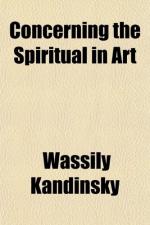It is often said that admission of the possibility of one art helping another amounts to a denial of the necessary differences between the arts. This is, however, not the case. As has been said, an absolutely similar inner appeal cannot be achieved by two different arts. Even if it were possible the second version would differ at least outwardly. But suppose this were not the case, that is to say, suppose a repetition of the same appeal exactly alike both outwardly and inwardly could be achieved by different arts, such repetition would not be merely superfluous. To begin with, different people find sympathy in different forms of art (alike on the active and passive side among the creators or the receivers of the appeal); but further and more important, repetition of the same appeal thickens the spiritual atmosphere which is necessary for the maturing of the finest feelings, in the same way as the hot air of a greenhouse is necessary for the ripening of certain fruit. An example of this is the case of the individual who receives a powerful impression from constantly repeated actions, thoughts or feelings, although if they came singly they might have passed by unnoticed. [Footnote: This idea forms, of course, the fundamental reason for advertisement.] We must not, however, apply this rule only to the simple examples of the spiritual atmosphere. For this atmosphere is like air, which can be either pure or filled with various alien elements. Not only visible actions, thoughts and feelings, with outward expression, make up this atmosphere, but secret happenings of which no one knows, unspoken thoughts, hidden feelings are also elements in it. Suicide, murder, violence, low and unworthy thoughts, hate, hostility, egotism, envy, narrow “patriotism,” partisanship, are elements in the spiritual atmosphere.
[Footnote: Epidemics of suicide or of violent warlike feeling, etc., are products of this impure atmosphere.]
And conversely, self-sacrifice, mutual help, lofty thoughts, love, un-selfishness, joy in the success of others, humanity, justness, are the elements which slay those already enumerated as the sun slays the microbes, and restore the atmosphere to purity.
[Footnote: These elements likewise have their historical periods.]
The second and more complicated form of repetition is that in which several different elements make mutual use of different forms. In our case these elements are the different arts summed up in the art of the future. And this form of repetition is even more powerful, for the different natures of men respond to the different elements in the combination. For one the musical form is the most moving and impressive; for another the pictorial, for the third the literary, and so on. There reside, therefore, in arts which are outwardly different, hidden forces equally different, so that they may all work in one man towards a single result, even though each art may be working in isolation.




